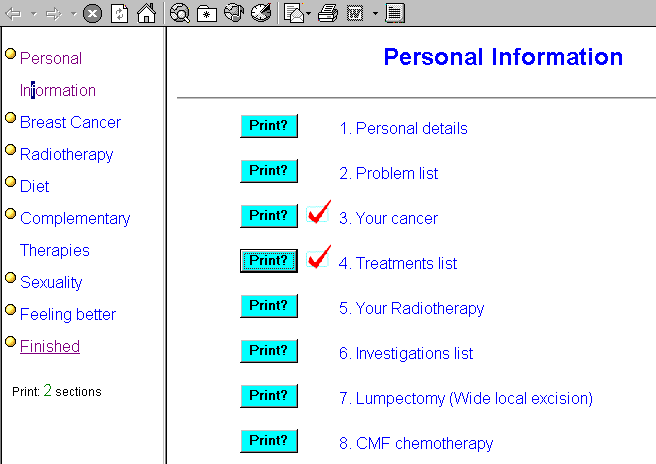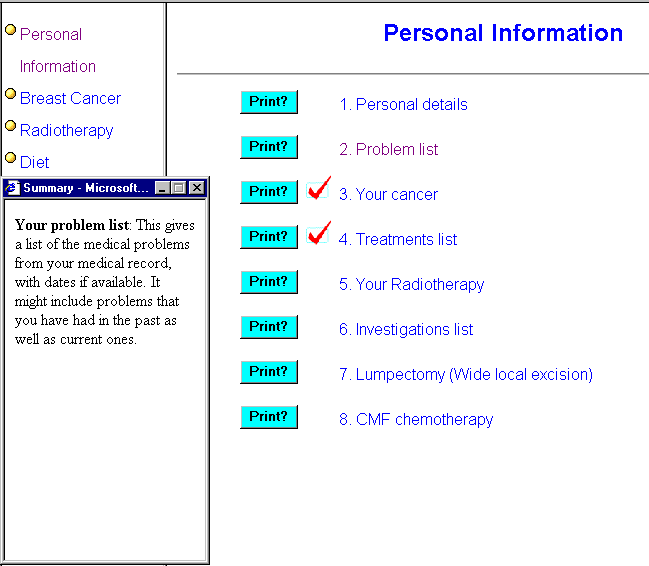 |
6. Further details on the intervention
Automatic general groups
All people randomised to the "automatic general" group received a printout based on CancerBACUP's information booklets on:
In order to reduce the size of the printout received by those in the automatic groups, some sections of the printed/web version of the booklets were omitted from this study.
Interactive general groups
Those in the interactive general groups (who chose the information they wanted included in their printout from a list of headings on-screen), were offered the same information as those in the automatic group and also information from:
All patients were offered the same number of possible choices.
How the information was presented to the Interactive groups
Each CancerBACUP booklet used in the study was broken down into its constituent parts and a relevant heading given. The headings followed the logical layout of the booklets, but some parts were grouped in order to make a more comprehensive printout. For example, in Cancer & complementary therapies, the sections in the booklet on counselling, relaxation, visualisation, art therapy, self-help groups, healing, and meditation, were all grouped under the heading ‘Psychological & self-help therapies’, as these together give a useful overview of what is available. Similarly in Diet & the cancer patient, all sections of part 3: ‘A healthy eating guide’, were grouped together. In other places it made more sense to keep to the original headings, such as in Diet & the cancer patient, parts 1 and 2, ‘The building-up diet’ and ‘Eating problems’. This allowed patients to choose only those headings that applied to their own case.
Personalisation
Patients randomised to the "personalised" groups received, or were offered a choice of, broadly similar information to those in the general groups, but with less relevant information omitted and personal details and explanatory information added. Choice of information included/excluded was based on information extracted from case notes.
Five specific personal information sections were added. These were:
Where appropriate, patients in the personalised groups were also offered more detailed information on specific investigations and treatments. For example a prostate patient might be offered information on the PSA test, Zoladex (a type of hormone therapy), and trans-urethral resection of the prostate (TURP); while a breast cancer patient might be offered information on lumpectomy, CancerBACUP’s fact sheets on Tamoxifen and various chemotherapy regimes or individual chemotherapy drugs (See example below). In contrast to this, the same breast cancer patient if in the general group would be offered general information on hormone therapy, chemotherapy, and breast surgery but not on drugs or operations specific to their own case.
The information on diet was personalised in as much as patients having or having had particular treatments were given/offered information about dealing with any problems that might arise from having those treatments such as a sore mouth, dry mouth, changed taste, in the case of patients having chemotherapy treatment, and also specific problems such as feeling sick, and coping with diarrhoea – all common side effects of chemotherapy.
For prostate patients, specific concerns would be dealing with various physical side effects of their radiotherapy such as diarrhoea and wind, and also feeling sick. Information on sore mouth, dry mouth etc were not included for these patients, as they are not included in the list of possible side effects for prostate cancer treatments.
The rest of the information on diet is very general and can apply to anyone, so was given, or offered, to everyone.
Complementary therapies, Sexuality & cancer & Controlling pain & other symptoms: All patients were offered the same choice of headings as those in the general group, with no extra omissions, although these had already been edited to some extent in order to reduce the size of the general printouts. For example in the CancerBACUP booklet Sexuality & cancer, there are section on how treatments can affect sexuality, with separate headings for how the different treatments affect men and women, so only the relevant sections were printed out or offered.
To summarise, the information offered to patients in the personalised groups was tailored according to type of cancer, treatments, investigations, also sex, age, and menopausal status in women. For example, post-menopausal women were not offered/given the sections on contraception or children (in the breast cancer section) or on fertility (in Radiotherapy), whereas pre-menopausal women were.
Example "Your cancer" section
This gives an example of what might be printed if the "Your cancer" heading is chosen by a breast cancer patient.
Your cancer
The following details are relevant to your breast cancer diagnosis:
Grading breast cancer
When a breast cancer is removed the tumour is always sent to a pathologist who provides a detailed report about it. This report includes comments on the naked-eye appearance of the cancer, the appearances under the microscope and often the results of some chemical tests.
The microscopic examination of the tumour will give information about which type of cell within the breast the cancer developed from and whether or not there are any cancer cells in the blood capillaries or lymph vessels. The microscopic examination will also give the grading of the cancer.
Depending on the appearances breast cancers are given one of three grades. Grade 1 is where the cancer cells look very like normal breast cells, with only slightly abnormal changes (these cancers are called 'well-differentiated'. Grade 3 is where the cells look very abnormal and show little or no resemblance to normal breast tissue (these cancers are called 'poorly differentiated'). Grade 2 is an intermediate grade (these cancers are called 'moderately differentiated').
The grade of a breast cancer is considered to be a guide to how aggressive the tumour is: a grade 2 cancer is likely to be more aggressive than a grade 1 and a grade 3 cancer is likely to be more aggressive than a grade 2. The grade of the cancer is, however, only one of a number of factors that doctors need to consider when predicting the outlook for individual patients and deciding on the treatment to give the best possible chance of cure. Among other important factors are the size of the cancer and whether or not it has spread to involve the lymph nodes under the arm.
Staging breast cancer
The stage of a cancer is a term used to describe its size and whether it has spread beyond its original site. Knowing the stage of the cancer and the grade helps the doctors decide on the most appropriate treatment. There are different staging systems for breast cancer, and the one used at the Beatson is described below. It is called the TNM system, where T stands for tumour, N stands for lymph nodes, and M stands for secondary cancer or metastases.
T1: The cancer measured less than 2cm across.
T2: The cancer measured between 2cm and 5cm.
T3 and T4: The cancer was bigger than 5cm.
N0 means that the cancer has not spread to the lymph nodes under the arm.
N1 and N2 mean that the cancer has spread to lymph nodes under the arm.
N3 means that the cancer has spread to lymph nodes in the neck.
M0 means that the cancer has not spread to other parts of the body.
Ductal carcinoma
A ductal carcinoma is a type of breast cancer that has started in one of the milk ducts. This is the most common type of breast cancer.
 |
ER Status
All breast cancers are tested and given an 'ER Status' (short for 'oestrogen receptor status'). This depends on whether or not the cancer is stimulated by oestrogen.
Oestrogen is a female sex hormone produced mainly by the ovaries. In some women, it can stimulate breast cancer to grow.
If your cancer has oestrogen receptors, it is said to be 'oestrogen receptor positive' (ER positive), and is likely to be stimulated by oestrogen. It is also likely to respond to treatment that blocks oestrogen - hormone therapy. Women with breast cancers that are 'ER positive' are usually prescribed a hormone drug such as tamoxifen to help stop their cancer coming back.
If your cancer doesn't have oestrogen receptors, it is said to be 'oestrogen receptor negative' (ER negative); and isn't likely to be stimulated by oestrogen.
Current national guidelines for the treatment of breast cancer recommend that if you are ER positive you should have tamoxifen and if you are ER negative you should have chemotherapy.
There are some circumstances when doctors recommend both types of treatment. Some specialists prefer to give tamoxifen to women, even if they are ER negative. Some trials have shown that it can help stop the cancer coming back.
Example screen shots
1) This shows the choices offered in the Personal Information section to a patient with breast cancer. The column on the far left shows the main subject headings. These are offered to all patients in the personalised, interactive groups. The first six categories on the main screen are common to all patients in the personalised groups, provided information is available. The other two (Lumpectomy and CMF chemotherapy) are included here because they are treatments relevant to this patient.
 |
2) This shows the same screen as above but with the summary window open. The patient has clicked on "Problems list" to view a summary of the information that will be printed out if that section is chosen.
 |